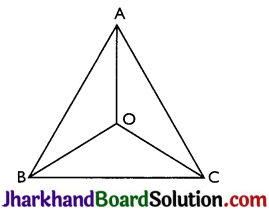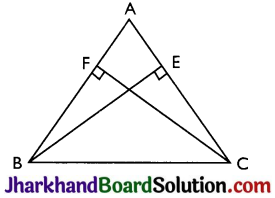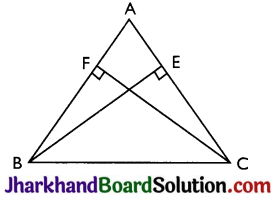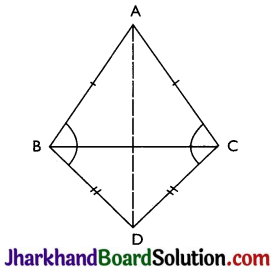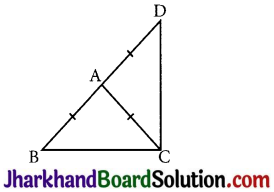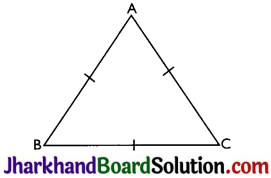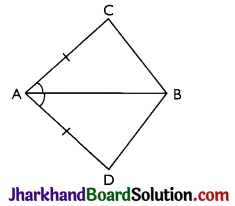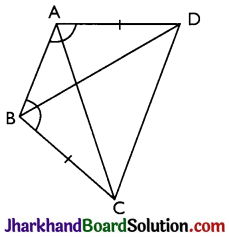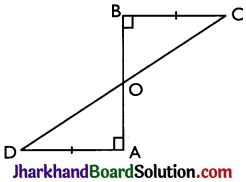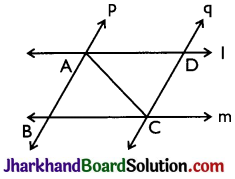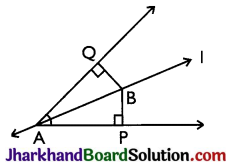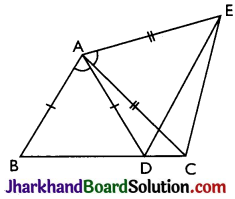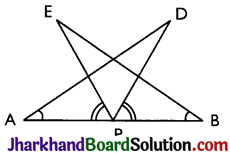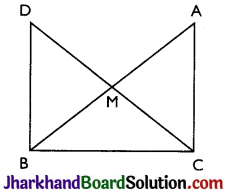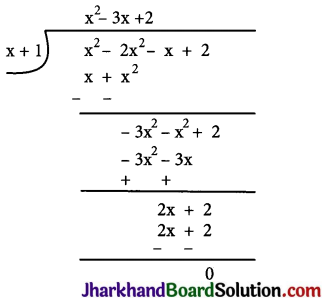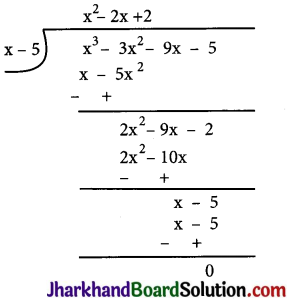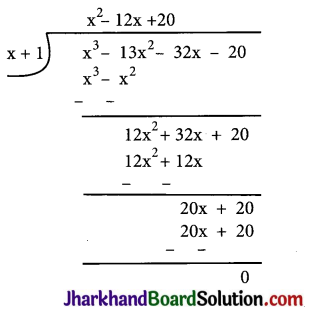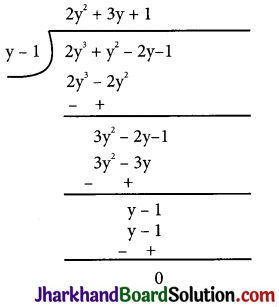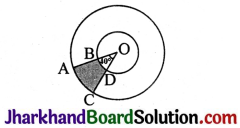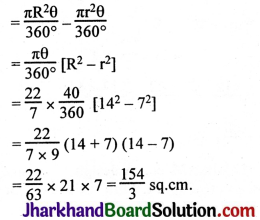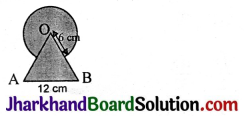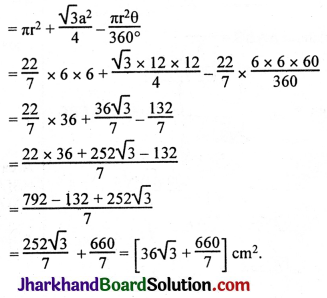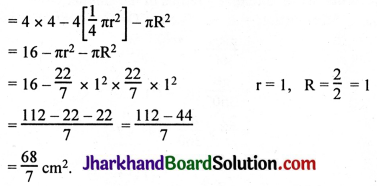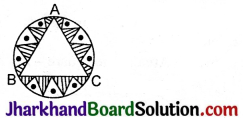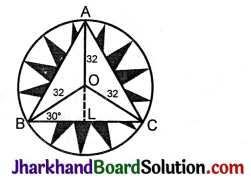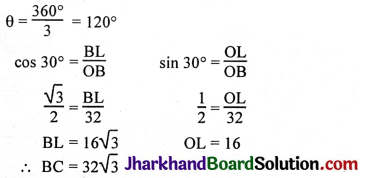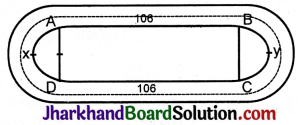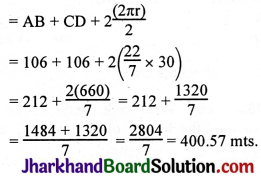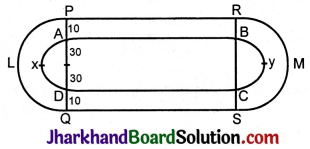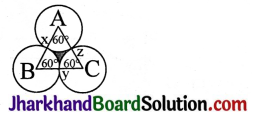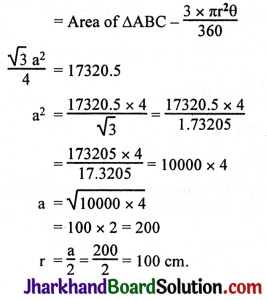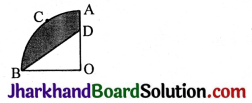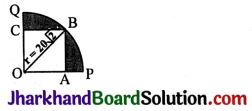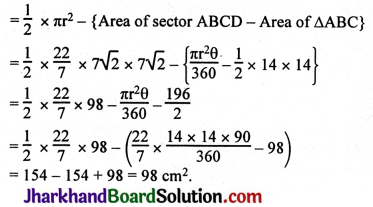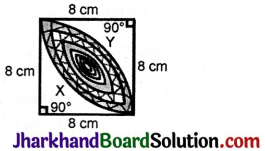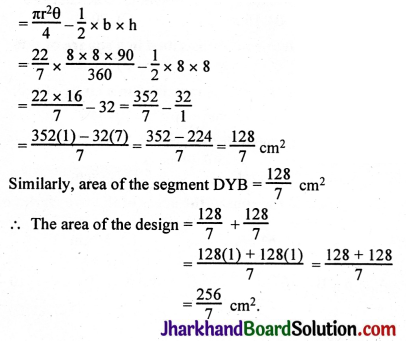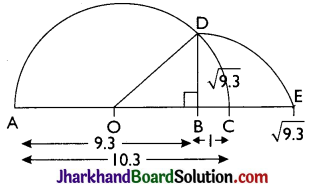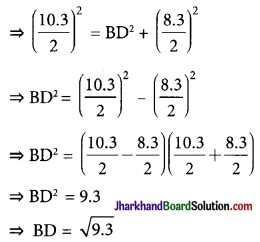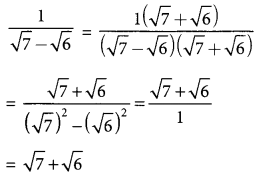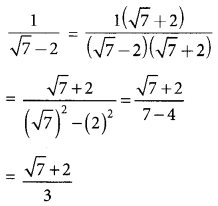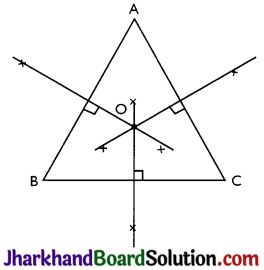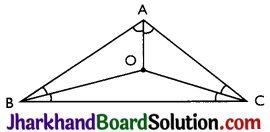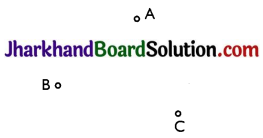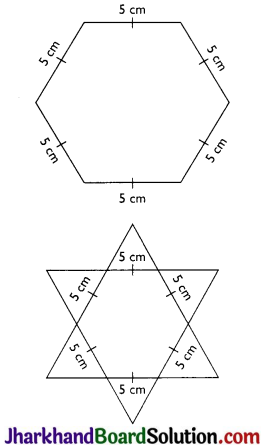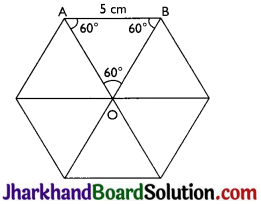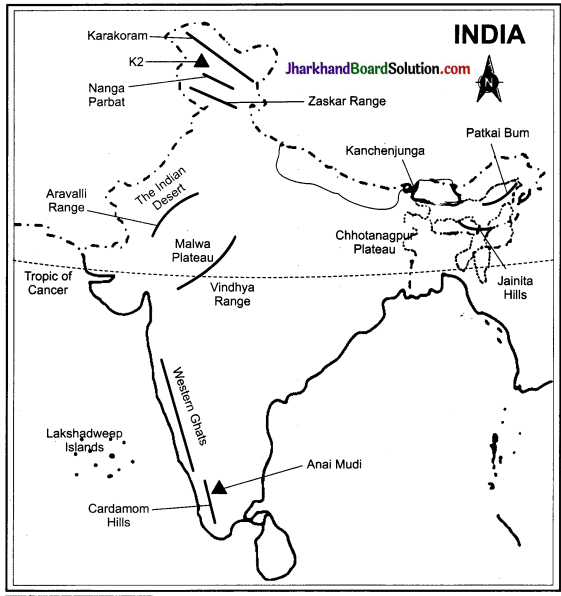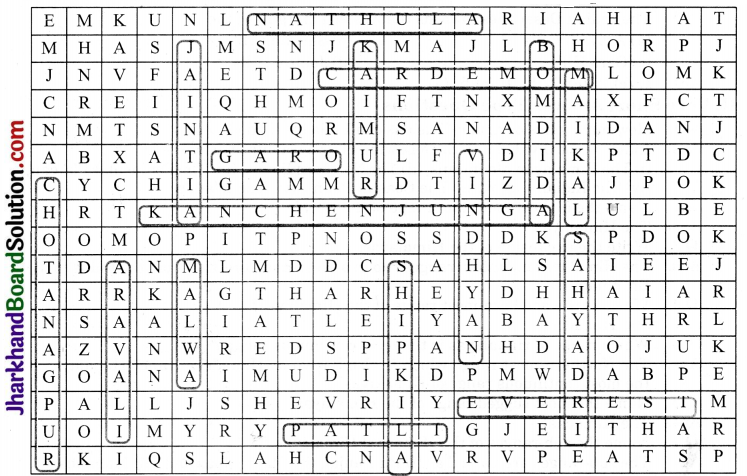Jharkhand Board JAC Class 9 Maths Solutions Chapter 8 Quadrilaterals Ex 8.2 Textbook Exercise Questions and Answers.
JAC Board Class 9th Maths Solutions Chapter 8 Quadrilaterals Ex 8.2
Page-150
Question 1.
ABCD is a quadrilateral in which P, Q, R and S are mid-points of the sides AB, BC, CD and DA (see Fig). AC is a diagonal. Show that:
(i) SR || AC and SR = \(\frac {1}{2}\)AC
(ii) PQ = SR
(iii) PQRS is a parallelogram.

Answer:
(i) In ΔDAC,
R is the mid-point of DC and S is the mid-point of DA.
Thus by mid-point theorem, SR || AC and SR = \(\frac {1}{2}\)AC
(ii) In ΔBAC,
P is the mid-point of AB and Q is the mid-point of BC.
Thus by mid-point theorem, PQ || AC
and PQ = \(\frac {1}{2}\) AC
Also, SR = \(\frac {1}{2}\) AC
Thus, PQ = SR
(iii) SR || AC (Proved)
and, PQ || AC (Proved)
⇒ SR || PQ (Lines parallel to same line are parallel to each other)
Also, PQ = SR(Proved)
Thus, PQRS is a parallelogram.
(A quadrilateral in which a pair of sides is equal and parallel is a parallelogram).

Question 2.
ABCD is a rhombus and P, Q, R and S are the mid-points of the sides AB, BC, CD and DA respectively. Show that the quadrilateral PQRS is a rectangle.
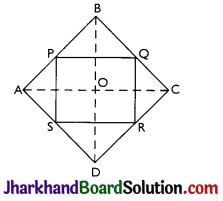
Answer:
Given: ABCD is a rhombus and P, Q, R and S are the mid-points of the sides AB, BC, CD and DA respectively.
To Prove: PQRS is a rectangle.
Construction: AC and BD are joined.
Proof: P and Q are mid-points of AB and BC respectively
⇒ PQ || AC and PQ = \(\frac{1}{2}\) AC …(i)
(By mid-point theorem)
Also, S are R are mid-points of AD and CD respectively, so, by mid-point theorem,
SR || AC and SR = \(\frac{1}{2}\)AC …(ii)
From (i) and (ii)
∴ PQ || SR and PQ = SR
⇒ PQRS is a parallelogram
As ABCD is a rhombus
AB = BC (sides of rhombus)
⇒ \(\frac{1}{2}\) AB = \(\frac{1}{2}\) BC
⇒ BP = BQ (As P and Q are mid-points of AB and BC respectively)
So, in ΔBPQ
∠BPQ = ∠BQP …(i)
(Angles opposite to equal sides are equal)
Also, BC = CD (Sides of rhombus)
⇒ \(\frac{1}{2}\) BC = \(\frac{1}{2}\) CD
⇒ CQ = CR (As Q and R are midpoint of BC and CD respectively)
So, in ACQR
∠CQR = ∠CRQ …(ii) (Angle opposites to equal sides are equal)
AB || CD (Opposite sides of a parallelogram)
⇒ ∠B + ∠C =180 …(iii)
(sum of angles on same sides of transversal is 180°)
In ΔBPQ, ∠BPQ + ∠BQP + ∠B = 180° (Angles sum property)
In ΔCQR, ∠CQR + ∠CRQ + ∠C = 180° (Angle sum property)
On adding both the equations, we get
∠BPQ + ∠BQP + ∠B + ∠CQR + ∠CRQ + ∠C = 360°
⇒ 180° + ∠BPQ + ∠BQP + ∠CQR + ∠CRQ = 360° [From (ii)]
⇒ 180° + 2 ∠BQP + 2 ∠CQR = 360° [From (i) and (ii)]
⇒ 2 (∠BQP + ∠CQR) = 360° – 180° = 180°
⇒ ∠BQP + ∠CQR = \(\frac{180°}{2}\) = 90° …(iv)
Now, ∠BQP + ∠CQR + ∠PQR = 180° (sum of angles on a straight line is 180°)
90° + ∠PQR = 180° [From (iv)]
⇒ ∠PQR = 180° – 90° = 90°
So, PQRS is a parallelogram in which one angle is 90°
⇒ PQRS is a rectangle.
Question 3.
ABCD is a rectangle and P, Q, R and S are mid-points of the sides AB, BC, CD and DA respectively. Show that the quadrilateral PQRS is a rhombus.
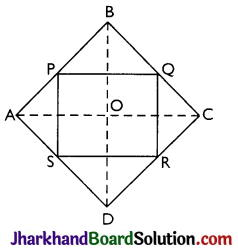
Answer:
Given: ABCD is a rectangle and P, Q, R and S are mid-points of the sides AB, BC, CD and DA respectively.
To Prove PQRS is a rhombus.
Construction: AC and BD are joined.
Proof: In ∆ABC
P and Q are the mid-points of AB and BC respectively
Thus, PQ || AC and PQ = \(\frac{1}{2}\) AC (Mid-point theorem) …(i)
In ∆ADC, SR AC and SR = \(\frac{1}{2}\) AC (Mid-point theorem) …(ii)
From (i) and (ii)
∴ PQ = SR and PQ || SR
⇒ PQRS is a parallelogram.
(As in quadrilateral PQRS one pair of opposite sides is equal and parallel to each other, so, it is a parallelogram.)
AB = CD (opposite sides of rectangle)
⇒ AB = CD
⇒ BP = CR(As P and R are midpoints of AB and CD respectively)
Consider ∆PBQ and ∆RCQ
BP = CR (Proved)
BQ = CQ [As Q is a mid-point of BC]
∠B = ∠C = 90° (As each angle of a rectangle ABCD is of 90°)
⇒ ΔPBQ ≅ ΔRCQ by SAS congruence criterion.
⇒ PQ = QR (CPCT)
Also, PQ = RS and PS = QR (As opposite sides of parallelogram are equal)
∴ PQ = QR = RS = PS
So, PQRS is a parallelogram in which all sides are equal.
⇒ PQRS is a rhombus.

Question 4.
ABCD is a trapezium in which AB || DC, BD is a diagonal and E is the mid-point of AD. A line is drawn through E parallel to AB intersecting BC at F (see Fig). Show that F is the mid-point of BC.
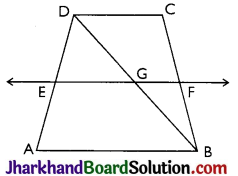
Answer:
Given: ABCD is a trapezium in which AB || DC, BD is a diagonal and E is the mid-point of AD.
To prove: F is the mid-point of BC.
Proof: BD intersects EF at G.
In ∆BAD,
E is the mid-point ofAD andalsoEG || AB.
Thus, G is the mid-point of BD (Converse of mid-point theorem)
Now, EG || AB
⇒ EF || AB
⇒ GF || AB
Also, AB || CD
∴ CD || GF (Lines parallel to same line are parallel to each other)
In ABCD, G is a mid-point of BD and CD || GF
⇒ F is a mid-point of BC (By converse of mid-point theorem)
Now, in ∆BDC,
G is the mid-point of BD and also GF || AB || DC.
Thus, F is the mid-point of BC (Converse of mid-point theorem)
Page-151
Question 5.
In a parallelogram ABCD, E and F are the mid-points of sides AB and CD respectively (see Fig). Show that the line segments AF and EC trisect the diagonal BD.
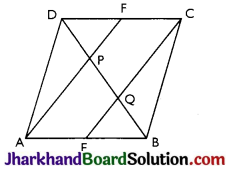
Answer:
Given: ABCD is a parallelogram. E and F are the mid-points of sides AB and CD respectively.
To prove: AF and EC trisect the diagonal BD.
Proof: ABCD is a parallelogram.
Therefore, AB || CD, also, AE || FC
Now, AB = CD (Opposite sides of parallelogram ABCD)
⇒ \(\frac{1}{2}\) AB = \(\frac{1}{2}\) CD
⇒ AE = FC (E and F are midpoints of sides AB and CD)
AECF is a parallelogram
(AE and CF are parallel and equal to each other)
AF || EC (Opposite sides of a parallelogram)
Now, in ADQC,
⇒ F is mid-point of side DC and FP || CQ (as AF || EC).
P is the mid-point of DQ (Converse of mid-point theorem)
⇒ DP = PQ …………(i)
Similarly, in AAPB,
E is mid point of side AB and EQ || AP (as AF || EC).
Q is the mid-point of PB (Converse of mid-point theorem)
⇒ PQ = QB ………….. (ii)
From equations (i) and (i),
DP = PQ = BQ
Hence, the line segments AF and EC trisect the diagonal BD.

Question 6.
Show that the line segments joining the mid-points of the opposite sides of a quadrilateral bisect each other.
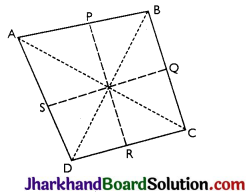
Answer:
Let ABCD be a quadrilateral and p, Q, R and S are the mid-points of AB, BC, CD and DA respectively.
Now, In ∆ACD, R and S are the mid-points of CD and DA respectively.
Thus SR || AC and SR = \(\frac{1}{2}\) AC (by mid-point theorem)
Also, in DABC, P and Q are mid-point of AB and BC respectively
⇒ PQ || AC and PQ = \(\frac{1}{2}\) AC (by mid-point theorem)
So, PQ = SR and PQ || SR.
Thus, PQRS is parallelogram, [since one pair of opposite sides is equal and parallel]
PR and QS are the diagonals of the parallelogram PQRS.
So, they will bisect each other. (As diagonals of a parallelogram bisect each other.)
Question 7.
ABC is a triangle right angled at C. A line through the mid-point M of hypotenuse AB and parallel to BC intersects AC at D. Show that
(i) D is the mid-point of AC
(ii) MD ⊥ AC
(iii) CM = MA = \(\frac {1}{2}\)AB

Answer:
(i) In ∆ACB
M is the mid-point of AB and MD|| BC
Thus, D is the mid-point of AC (Converse of mid-point theorem)
(ii) ∠ACB = ∠ADM (Corresponding angles)
As ∠ACB = 90°
Thus, ∠ADM = 90° i.e. MD ⊥ AC
(iii) In ∆AMD and ∆CMD,
AD = CD (D is the mid-point of side AC)
∠ADM = ∠CDM (Each 90°)
DM = DM (common)
Thus, ΔADM ≅ ΔCDM by SAS congruence criterion.
AM = CM by CPCT
also, AM = \(\frac{1}{2}\) AB (M is mid point of AB)
Hence, CM = MA = \(\frac{1}{2}\) AB
![]()
